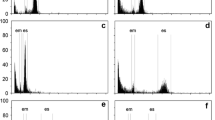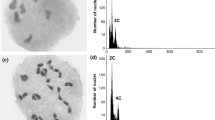Summary
The production of 2n pollen (pollen with the sporophytic chromosome number) was evaluated in 4x and 6x taxa of Vaccinium section Cyanococcus. Mean frequencies of 2n pollen producers were 17.1% and 8.3% in natural 4x and 6x populations, respectively. The frequency of 2n pollen producers in the 4x species ranged from 8.6% (V. angustifolium) to 23.8% (V. pallidum). Level of 2n pollen production was genotypically variable (1% to 37.4%). The widespread occurrence of 2n pollen in 2x, 4x and 6x taxa suggests that sexual polyploidization was widespread and responsible for the origin of the polyploid species found in this genus. The frequency of 2n pollen producers was not significantly different between the 4x species and their putative 2x ancestors. These results support the origin of 4x and 6x taxa as a consequence of sexual polyploidization. Polyploids derived from sexual polyploidization would be expected to have increased fitness and flexibility due to the mode of 2n pollen formation. In blueberry species the predominant mode of 2n pollen formation is genetically equivalent to a first division restitution mechanism (FDR). FDR 2n pollen transmits a high percentage of the heterozygosity and a large fraction of the epistasis from the 2x parent to the 4x offspring.
Similar content being viewed by others
References
Camp, W.H., 1945. The North American blueberries with notes on other groups of Vacciniaceae. Brittonia 5: 203–275.
Cockerham, L.E. & G.J. Galletta, 1976. A survey of pollen characteristics in certain Vaccinium species. J. Amer. Soc. Hort. Sci. 101: 671–676.
Dweikat, I.M. & P.M. Lyrene, 1988. Production and viability of unreduced gametes in triploid interspecific blueberry hybrids. Theor. Appl. Genet. 76: 555–559.
Fienberg, S.W., 1977. The analysis of cross classified data. MIT Press, Cambridge, MA.
Harlan, J.R. & J.M.J. de Wet, 1975. On Ö. Winge and a prayer: the origins of polyploidy. Bot. Rev. 41: 361–369.
Koduru, P.R.K. & M.K. Rao, 1981. Cytogenetics of synaptic mutants in higher plants. Theor. Appl. Genet. 59: 197–214.
Krebs, S.L. & J.F. Hancock, 1988. The consequences of inbreeding on fertility in V. corymbosum. J. Amer. Soc. Hort. Sci. 113: 914–918.
Mackey, J., 1970. Significance of mating system for chromosome and gametes in polyploids. Hereditas 66: 165–176.
McCoy, T.J., 1982. The inheritance of 2n pollen formation in diploid alfalfa Medicago sativa. Can. J. Genet. Cytol. 24: 315–323.
Ortiz, R., N. Vorsa, L.P. Bruederle & T. Laverty, 1992. Occurrence of unreduced pollen in diploid blueberry species, Vaccinium Sect. Cyanococcus. Theor. Appl. Genet. In press.
Peloquin, S.J., 1982. Meiotic mutants in potato breeding. Stadler Genet. Symp. 14: 99–109.
Peloquin, S.J., G.L. Yerk & J.E. Werner, 1989. Ploidy manipulations in potato. In: K.W. Adolph (Ed.) Chromosomes: Eukaryotic, prokaryotic, and viral. Vol. II. CRC Press, Boca Raton, FL. pp. 167–178.
Sharpe, R.H. & G.M. Darrow, 1959. Breeding blueberries for the Florida climate. Proc. Fla. State Hortic. Soc. 72: 308–311.
Stebbins, G.L., 1950. Variation and evolution in plants. Columbia Univ. Press, New York.
Stebbins, G.L., 1971. Chromosomal evolution in higher plants. Addison-Wesley, London.
Stushnoff, C. & L.J. Hough, 1968. Sporogenesis and gametophyte development in ‘Bluecrop’ and ‘Coville’ highbush blueberries. Proc. Amer. Soc. Hort. Sci. 93: 242–247.
Stushnoff, C. & B.F. Palser, 1969. Embryology of five Vaccinium taxa including diploid, tetraploid and hexaploid species or cultivars. Phytomorphology 19: 312–331.
Vorsa, N., 1986. Cytology of 2n pollen formation in a Vaccinium ashei/corymbosum hybrid. HortScience 21: 315.
Vorsa, N. & R. Ortiz, 1992. Cytology of 2n pollen formation in a blueberry aneuploid (2n=4x+9=57). J. Hered. In press.
Watanabe, K., S.J. Peloquin & M. Endo, 1991. Genetic significance of mode of polyploidization: somatic doubling or 2n gametes. Genome 34: 28–34.
Yates, F., 1934. Contingency tables involving small numbers and the X2 test. J. Roy. Statist. Soc. Supp. 1: 217–235.
Author information
Authors and Affiliations
Rights and permissions
About this article
Cite this article
Ortiz, R., Bruederle, L.P., Laverty, T. et al. The origin of polyploids via 2n gametes in Vaccinium section Cyanococcus . Euphytica 61, 241–246 (1991). https://doi.org/10.1007/BF00039664
Received:
Accepted:
Issue Date:
DOI: https://doi.org/10.1007/BF00039664




